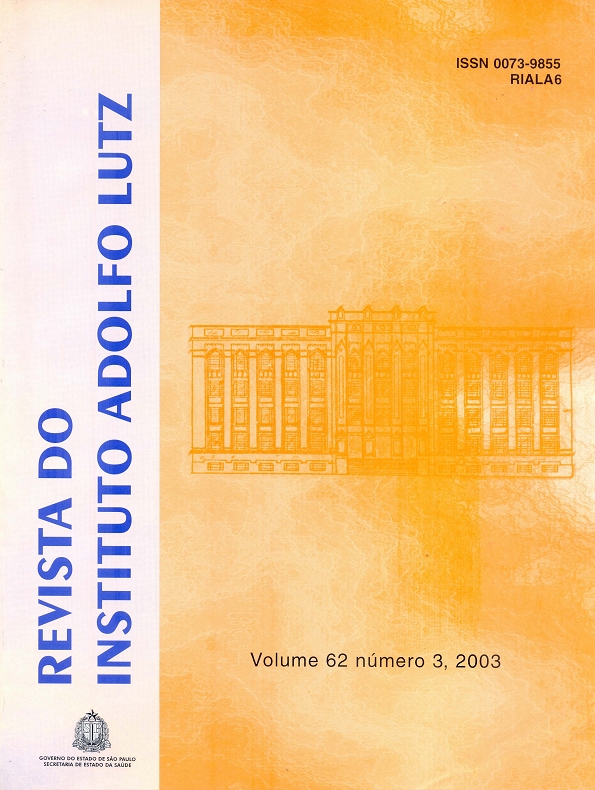Abstract
Eighty seven samples of peanuts and peanut products commercialized in the region of
Marília/SP, Brazil in the period of 1999 to 2001 were analyzed in order to identify and quantify aflatoxin B1
and G1, determined by thin-layer chromatography (TLC), according to the method described by Soares
and Rodriguez-Amaya. Aflatoxins were found in 56 (64,4%) of the samples and 34 (39,1%) exceeded the limits of the Brazilian legislation valid in that period which, for aflatoxin B1+G1, was 30 µg/kg. The aflatoxins concentration in the samples varied from 3 to 1659 µg/kg and the average of positive samples was 306µg/kg. In 31 (35,6%) samples were not detected aflatoxins and the 90th percentil was 601 µg/kg. Data of temperature and level of the rains in the same period showed that high levels of aflatoxins had agreed with high levels of temperature and rains and probably, it resulted on this contamination. Our studies showed that aflatoxin contamination exists, mainly due to conditions of temperature and humidity prevalent in the
region of Marília that are favorable of fungal growth. A good crop management technique and the
continuous and systematic monitoring is the best way to prevent and control the infestation of agricultural products with toxigenic moulds.
References
1. Brasil. Leis, Decretos, etc. Resolução n° 34/76 da Comissão de Normas e Padrões para Alimentos. Diário Oficial, Brasília, DF, Sec. I, p 710, 19 de janeiro de 1977.Fixa padrões de tolerância para as aflatoxinas em alimentos.
2. Brasil. Leis, Decretos, etc. Resolução – RDC n° 274 de 15/10/2002 da ANVISA. Diário Oficial da União, Brasília, DF, Sec. I, 16 de outubro de 2002. Aprova o Regulamento Técnico sobre limites máximos de aflatoxinas no leite, amendoim e milho.
3. Brigido, B.M.; Badolato, M.I.C.; Freitas, V.P.S. Contaminação de amendoim e seus produtos comercializados na região de Campinas – SP por aflatoxinas durante o ano de 1994. Rev. Inst. Adolfo Lutz, 55(2): 85-90, 1995.
4. Bullerman, L.B; Schroeder, L.L.; Park, K.Y. Formation and Control of Mycotoxins in Food. J. Food. Prot., 47(8): 637-646, 1984.
5. Chu, F.S. Mycotoxins: food contaminations, mechanism, carcinogenic potencial and preventive measures. Mutat. Res., 259: 291-306, 1991
6. Codex Alimentarius – Codex Committee on Food Additives and Contaminants – Discussion Paper on the Development of a Code of Practice for the Reduction of Aflatoxin Contamination in Peanuts – CX/FAC 03/25 – nov/2002.
7. Diener, U.L.; Davis, N.D. Limiting temperature and relative humidity for growth and production of aflatoxin and free fatty acids by Aspergillus flavus in sterile peanuts. J. Am. Oil Chem. Soc., 44: 259-263, 1987.
8. Freitas, V.P.S.; Brigido, B.M. Occurrence of aflatoxins B1, B2, G1 and G2 in peanuts and their products marketed in the region of Campinas, Brazil in 1995 and 1996. Food Addit. Contam.,15(7): 807-811, 1985.
9. IARC. Some naturally occurring substances: food items and constituents, heterocyclic aromatic amines and mycotoxins., IARC Monographs on the Evaluation of Carcinogenic Risks to Humans. Lyon, International Agency for Research on Cancer 1993, 56: 254-395.
10. Martins-Maciel, E.R. et al. Incidence of aflatoxins and Aspergillus flavus in peanuts consumed in Maringá city, Brazil. Arq. Biol. Tecnol., 39(4): 807-813, 1996.
11. Moss, M.O. Mycotoxins of Aspergillus and other Filamentous Fungi. J. Appl. Bacteriol. Symp. Suppl.: 69S-81S, 1989.
12. Moss, M.O. Economic Importance of Mycotoxins – Recent Incidence. Int. Biodeterior. Biodegradation, 27:195-204, 1991.
13. OPAS. Organización Panamericana de la Salud. Micotoxinas. Criterios de Salud Ambiental 11, Washington, OPAS, 1983, 131 p.
14. Park, L.; Liang, B. Perspectives on Aflatoxin Control for Human Food and animal feed. Trends Food Sci. Tech., 4: 334-342, 1993.
15. Pittet, A. Natural Occurrence of Mycotoxins in Foods and Feeds: A Decade Review. In: Koe, WJ, Samson RA, van Egmond HP, Gilbert J, Sabino M (Ed). Mycotoxins and Phycotoxins in Perspective at the Turn of the Millennium. Wageningen, The Netherlands: 2001, p.153-172.
16. Prado, G. Incidência de Aflatoxina B1 em Alimentos. Rev. Farm. Bioquím., 5:147-157, 1983.
17. Sabino, M. et al. A Survey of the Occurrence of Aflatoxins in groundnut (peanuts) and groundnut products in São Paulo State/Brazil in 1994. Rev. Inst. Adolfo Lutz, 58(1): 53-57, 1999.
18. Sabino, M. et al. Occurrence of Aflatoxins in Peanuts and Peanuts Products Consumed in the State of São Paulo/Brazil from 1995 to 1997. Rev. Microbiol., 30: 85-88, 1999.
19. Scott, PM. – Natural Toxins. In: Association of Official Analytical Chemists – Official Methods of Analysis of the Association of Official Analytical Chemists. 16th ed. Maryland: 1997, cap 49, p.26-27.
20. Secretaria de Agricultura e Abastecimento. Coordenadoria de Assistência Técnica Integral (CATI) – Regional de Marília. Escritório de Desenvolvimento Rural. Observações termo-pluviométricas, 1998, 1999, 2000 e 2001.
21. Soares, L.V.; Rodriguez-Amaya, D.B. Survey of aflatoxins, ochratoxin A, zearalenone and sterigmatocystin in some Brazilian foods by using a multitoxin thin-layer chromatographic method. J. Assoc. Off. Anal. Chem., 72 (1):22-26, 1989.

This work is licensed under a Creative Commons Attribution 4.0 International License.
Copyright (c) 2003 Revista do Instituto Adolfo Lutz
